Sourdough bread may support better digestion, improve mineral absorption, and offer steadier blood sugar levels compared to conventional bread.
Its unique fermentation process with lactic acid bacteria (LAB) and wild yeast transforms ordinary flour into a more digestible, nutrient-rich loaf. Understanding the science behind sourdough helps you make informed, healthier bread choices — especially if you care about gut health, blood sugar balance, or nutrient absorption.

In this guide, we’ll explore 10 evidence-based health benefits of sourdough bread, its nutritional value, possible side effects, and tips for choosing the best loaf. All insights are based on recent reviews (2023–2025) from authoritative nutrition and health sources such as the USDA, Frontiers in Nutrition, Harvard Health, and Monash University.
What Is Sourdough Bread? (Overview and Nutrition Profile)
Sourdough bread is a naturally fermented bread made using wild yeast and lactic acid bacteria (LAB) instead of commercial baker’s yeast.
This traditional fermentation process transforms flour and water into a live culture called a starter, which gives sourdough its signature tangy flavor, chewy texture, and enhanced digestibility.
During fermentation, LAB produce organic acids, enzymes, and postbiotic compounds that break down starches, gluten, and phytates. This makes sourdough more nutrient-dense and easier for many people to digest than conventionally leavened bread.
Unlike most commercial breads, sourdough requires long fermentation periods (12–24 hours), allowing for deeper flavor development and natural preservation — no chemical additives or artificial yeast needed.
According to Harvard T.H. Chan School of Public Health, whole-grain versions of fermented breads like sourdough provide more fiber, vitamins, minerals, and phytonutrients that support heart and gut health.
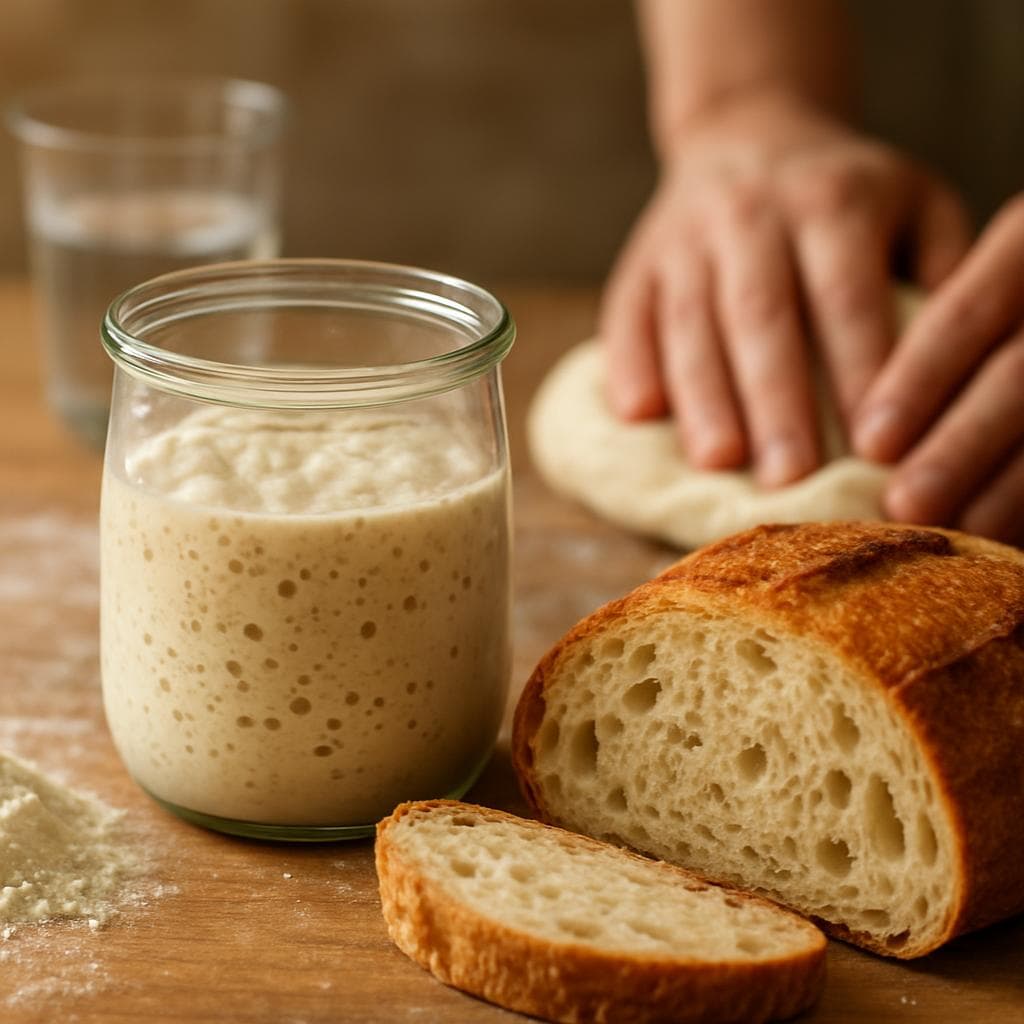
Nutritional Profile (Per 1 Medium Slice, ~56 g)
(Source: USDA FoodData Central, 2024)
| Nutrient | Amount (per slice) | Key Benefits |
|---|---|---|
| Calories | ~100 kcal | Provides moderate energy |
| Carbohydrates | 20 g | Primary source of energy |
| Dietary Fiber | 1–2 g | Supports digestion & gut health |
| Protein | 4 g | Aids in tissue repair and satiety |
| Fat | 0.5 g | Low in total and saturated fat |
| Iron | 0.9 mg | Important for oxygen transport |
| Magnesium | 8 mg | Supports muscle and nerve function |
| Zinc | 0.3 mg | Contributes to immune function |
| Sodium | 160–180 mg | Naturally occurring + added salt |
| Folate (B9) | 12 µg | Supports red blood cell formation |
Why the Fermentation Matters
- Enhances nutrient absorption: Fermentation breaks down phytic acid, unlocking minerals like magnesium and zinc.
- Improves flavor and texture: Organic acids give sourdough its signature tang and chewy crust.
- Extends shelf life naturally: Acidity and organic acids inhibit mold, reducing the need for preservatives.
- May support digestion: LAB activity pre-digests starches and proteins, making the bread gentler on the gut.
Key takeaway:
Sourdough bread isn’t just another bread trend — it’s a naturally fermented, nutrient-rich food that may support gut and heart health while offering better digestibility than standard yeast-based breads.
10 Proven Health Benefits of Sourdough Bread (Backed by Science)
Sourdough bread offers more than great flavor — its slow fermentation process may enhance nutrient absorption, support digestion, and improve overall wellness. Below are 10 science-backed health benefits explained in detail, following the latest data from Harvard Health, Cleveland Clinic, Monash University, and Frontiers in Nutrition.
1. Supports Healthy Digestion
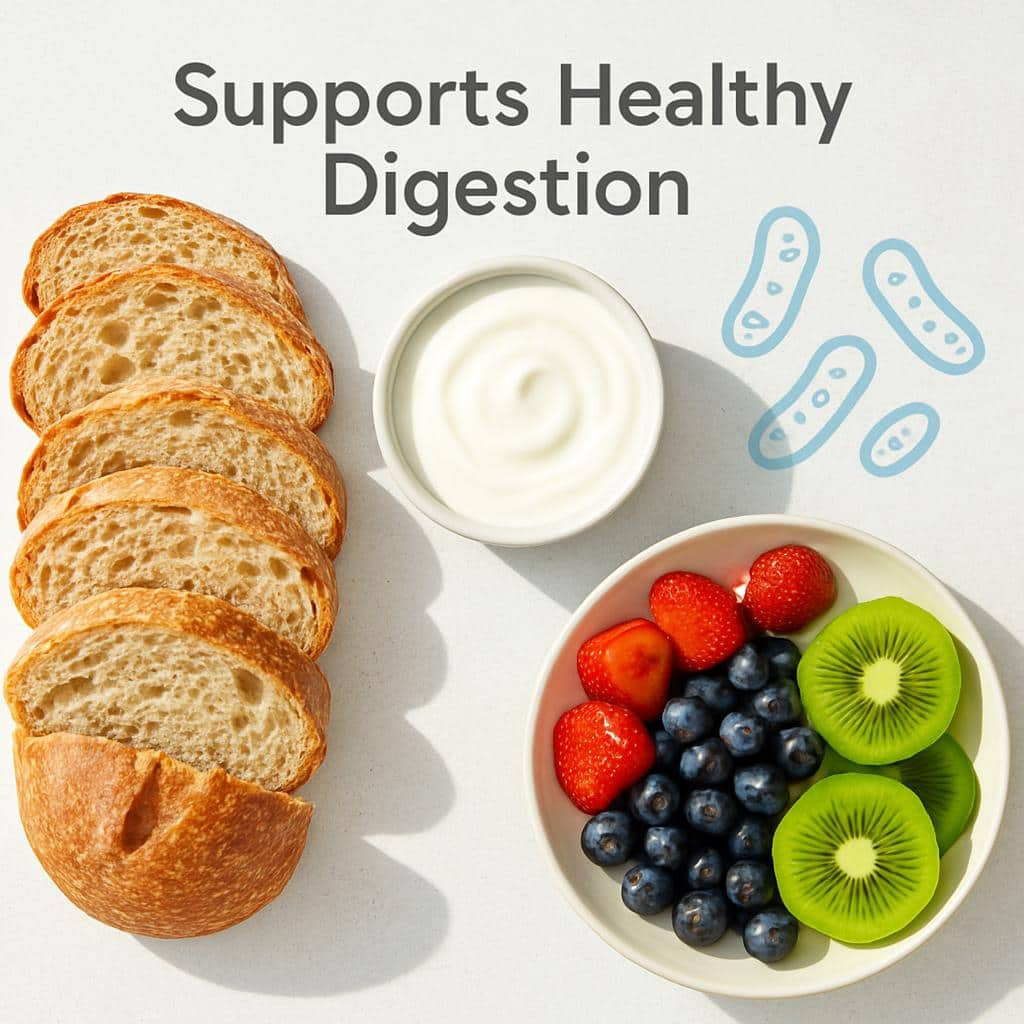
The lactic acid bacteria (LAB) in sourdough fermentation help pre-digest complex carbohydrates and gluten into simpler forms, which may make the bread easier on your digestive system. These beneficial bacteria also reduce FODMAPs — short-chain carbohydrates that can cause bloating and discomfort in sensitive individuals.
According to Monash University’s Low FODMAP Program (2023), properly fermented sourdough can contain lower levels of these compounds compared to conventional bread. The slow fermentation also produces organic acids that may support a balanced gut environment.
➡️ Tip: Choose long-fermented, whole-grain sourdough for better gut comfort and nutrient retention.
2. May Help Stabilize Blood Sugar Levels
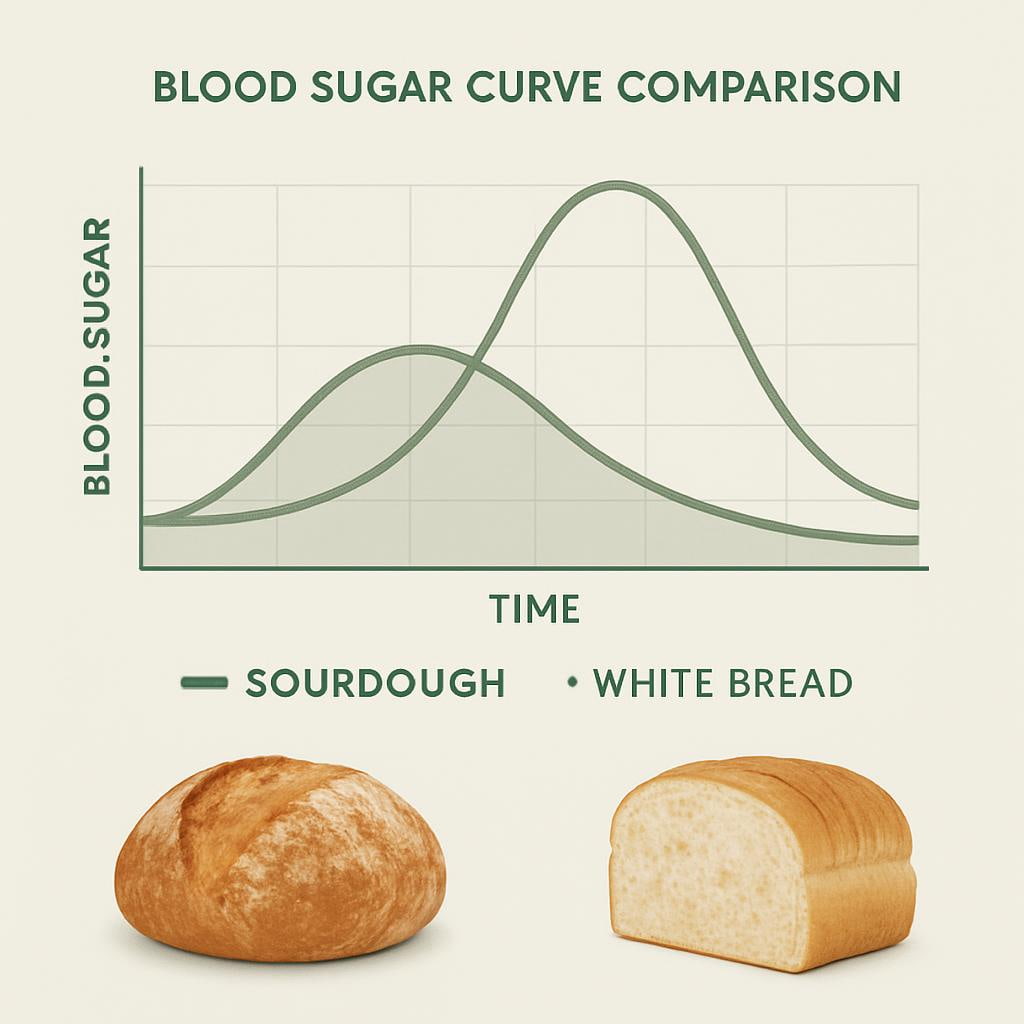
Sourdough bread’s natural fermentation process changes the way carbohydrates are digested. The lactic and acetic acids formed during fermentation slow the breakdown of starch into glucose, leading to steadier blood sugar levels after eating.
A 2023 review in Frontiers in Nutrition found that sourdough breads often have a lower glycemic index than standard white breads, though the benefits depend on the type of flour and fermentation time.
➡️ Tip: Combine sourdough with protein or healthy fats (like eggs, nut butter, or avocado) to further support blood sugar balance.
3. Improves Mineral Absorption
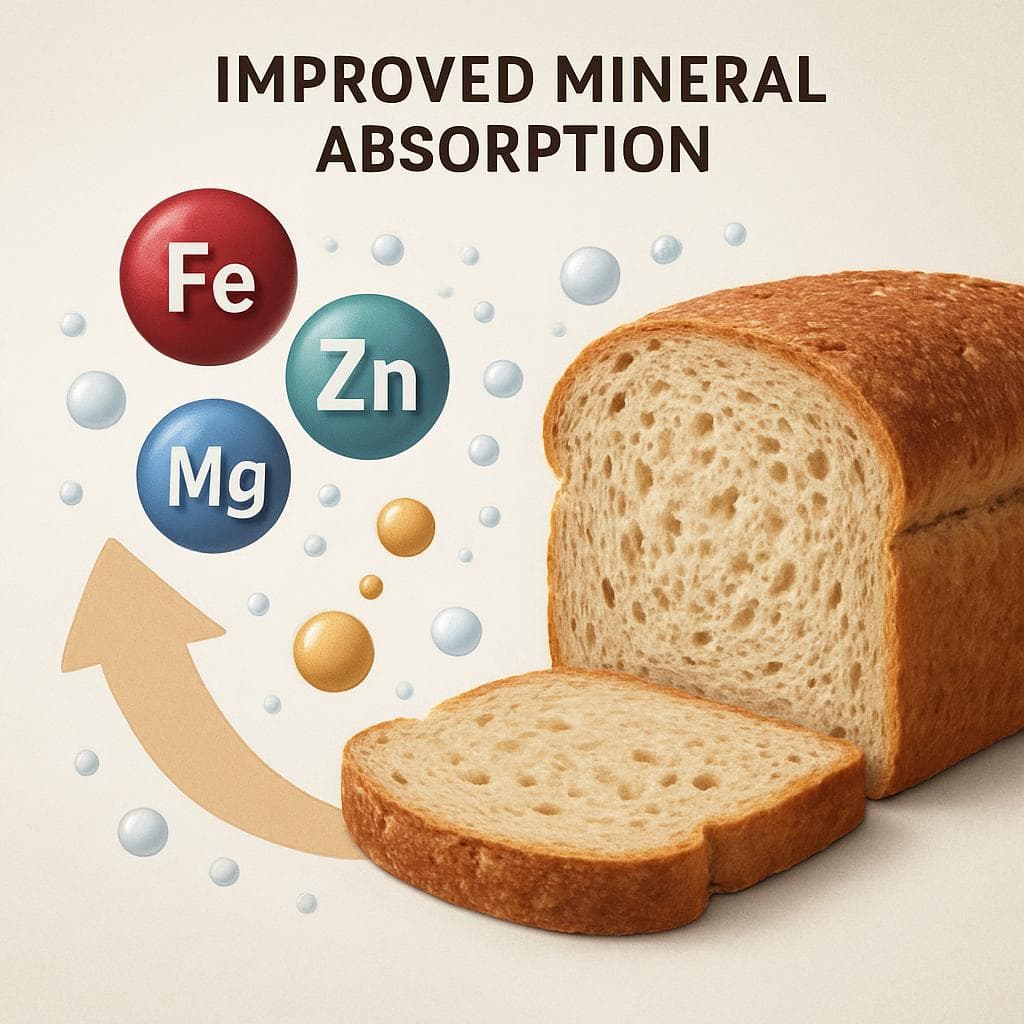
Whole grains naturally contain phytic acid (phytate) — a compound that binds to minerals such as iron, zinc, and magnesium, making them harder for the body to absorb. During sourdough fermentation, the natural acidity and enzyme activity (particularly phytase) help break down phytic acid, thereby releasing more bioavailable minerals for the body to use effectively.
A study published in the American Journal of Clinical Nutrition found that phytic acid significantly reduced magnesium absorption from bread, underscoring the importance of fermentation in improving mineral uptake (PubMed, 2004). Similarly, the Cleveland Clinic emphasizes that whole grains—especially when fermented—offer a superior nutrient profile because they retain essential vitamins and minerals often lost in refined grains.
By choosing sourdough bread made with whole-grain flour and longer fermentation, you benefit from improved mineral absorption, better nutrient retention, and overall enhanced nutritional quality.
➡️ Tip: Opt for whole-grain sourdough to get the maximum benefits of iron, magnesium, zinc, and antioxidants while supporting overall metabolic and bone health.
4. May Support Gut Health via Postbiotics
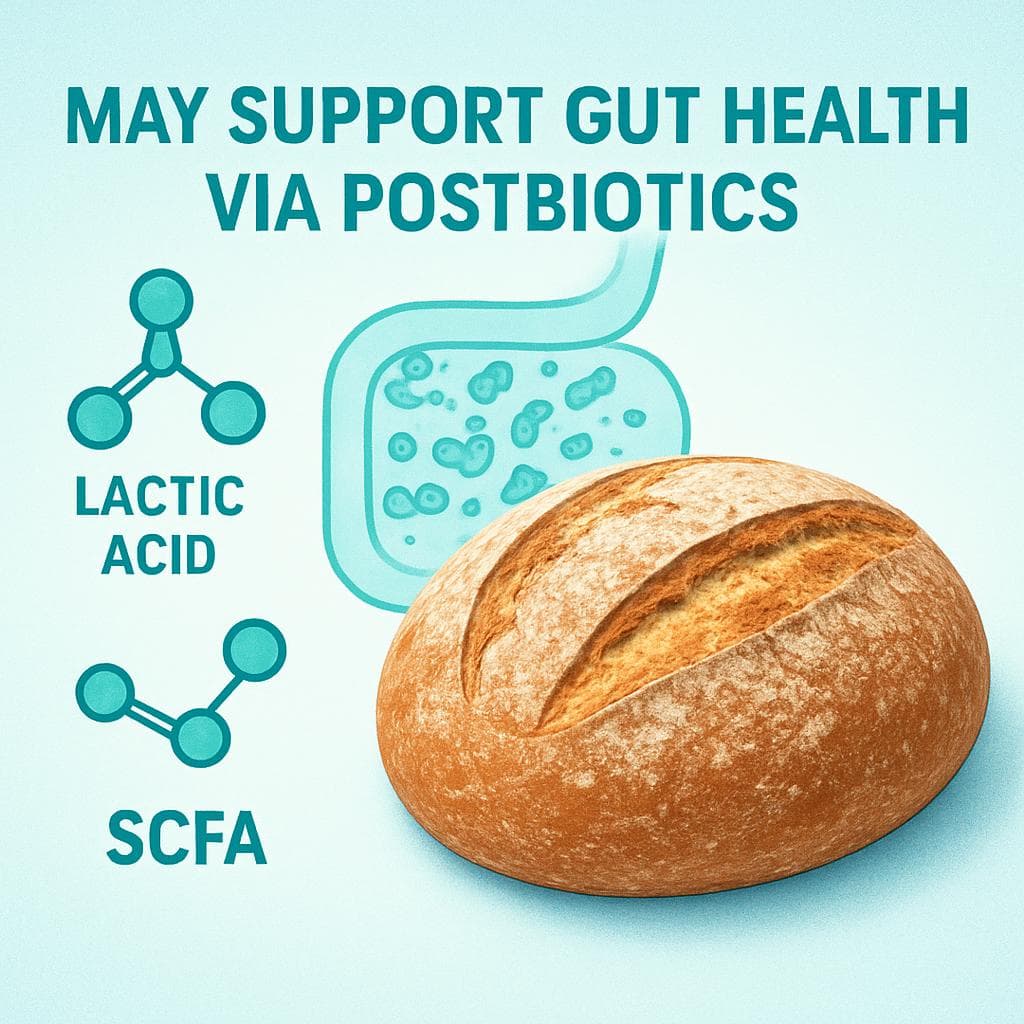
Although sourdough bread is not a probiotic food (since baking destroys most live bacteria), it is naturally rich in postbiotics — beneficial compounds produced during fermentation, including lactic acid, peptides, and short-chain fatty acids. These postbiotics are known to support gut microbiome balance, maintain the intestinal barrier, and may help regulate local inflammation.
According to Harvard Health Publishing (2024), postbiotics are emerging as key players in digestive health. They may help improve gut function by supporting the growth of beneficial bacteria, enhancing immune defense, and maintaining a balanced internal environment.
The fermentation process that creates sourdough encourages the production of these bioactive compounds, making it a valuable part of a gut-supportive diet. While it doesn’t replace probiotic foods, its postbiotic content may complement other fermented options for better overall gut wellness.
➡️ Tip: Incorporate a mix of naturally fermented foods like sourdough bread, yogurt, kefir, or kimchi to promote gut diversity and support digestive balance safely and effectively.
5. May Enhance Satiety and Weight Management

Sourdough bread may keep you feeling full for longer due to its unique fermentation chemistry. The production of organic acids slows starch digestion, while cooling sourdough after baking increases resistant starch — a form of carbohydrate that resists digestion and may support healthy weight management.
Research published in Frontiers in Nutrition (2024) shows that resistant starch helps stabilize energy levels and may reduce overeating by promoting satiety hormones.
➡️ Tip: Toast and cool sourdough before eating to boost resistant starch formation and support sustained energy.
6. Contains Fewer Preservatives and Additives

Traditional sourdough bread relies on its natural acidity and organic acids to prevent spoilage, eliminating the need for synthetic preservatives. The mild antimicrobial properties of lactic acid bacteria inhibit mold and bacterial growth, which keeps the bread fresher for longer without chemical additives.
This makes sourdough an appealing choice for people seeking clean-label foods and fewer artificial ingredients. The USDA also supports choosing minimally processed grains for optimal health outcomes.
7. May Support Heart Health

Whole-grain sourdough varieties are a good source of fiber, potassium, and magnesium — nutrients known to support healthy blood pressure and cholesterol levels. The American Heart Association emphasizes that fiber-rich whole grains can help reduce the risk of heart disease when consumed as part of a balanced diet.
The fermentation process also helps improve glycemic control, indirectly supporting heart function by reducing blood sugar fluctuations and inflammation.
➡️ Tip: Choose whole-grain or rye sourdough to increase fiber intake and support cardiovascular wellness.
Reference: American Heart Association – Whole Grains and Heart Health (2024).
8. May Improve Protein Digestibility

Fermentation partially hydrolyzes gluten proteins, improving their digestibility for some people without celiac disease. The natural acidity also alters protein structure, making it easier for digestive enzymes to process.
However, it’s critical to note that sourdough bread is not gluten-free. According to Beyond Celiac (2025), individuals with celiac disease or severe gluten intolerance should avoid wheat-based sourdough unless it is certified gluten-free.
➡️ Tip: For sensitive individuals, look for gluten-free sourdough made from rice, quinoa, or buckwheat flour.
9. Rich in Antioxidants

Fermentation enhances antioxidant compounds such as ferulic acid, phenolic acids, and lutein, which may help protect the body from oxidative stress and cellular damage. These antioxidants are especially abundant in whole-grain sourdough, where the bran and germ remain intact.
A 2024 analysis published in the Journal of Cereal Science found that sourdough fermentation significantly increases antioxidant activity compared to standard yeast breads.
➡️ Tip: Choose dark or seeded sourdough loaves for the highest antioxidant potential.
10. May Be Easier on the Gut for Some IBS Sufferers
People with irritable bowel syndrome (IBS) often struggle with high-FODMAP foods. During sourdough fermentation, bacteria consume many of these fermentable sugars, resulting in lower FODMAP levels compared to conventional bread.
Research from the Monash University Low FODMAP Program shows that properly fermented sourdoughs made from spelt or rye may be better tolerated by those with IBS symptoms. However, results vary based on fermentation time, temperature, and grain type.
Possible Side Effects and Precautions
While sourdough bread offers several health advantages, some people may need to monitor intake or choose specific types based on dietary needs or medical conditions. Below is a fact-based safety table summarizing key considerations.
| Concern | Description | Safe Guidance | Authoritative Source |
|---|---|---|---|
| Gluten Content | Regular sourdough made from wheat or rye still contains gluten. It is not safe for those with celiac disease or severe gluten intolerance. | Choose certified gluten-free sourdough made from rice, quinoa, or buckwheat. | Beyond Celiac |
| Sodium Levels | Many commercial breads contain 150–200 mg sodium per slice, which can add up quickly in the diet. | Select low-sodium versions or limit to 1–2 slices per meal to stay within the CDC’s sodium guideline of <2,300 mg daily. | Centers for Disease Control and Prevention (CDC) |
| FODMAP Variation | Not all sourdough breads are low in fermentable carbohydrates. Short fermentation can leave residual FODMAPs that trigger bloating in IBS. | Opt for long-fermented spelt or rye sourdough listed as low-FODMAP in the Monash University Low FODMAP Program database. | Monash University |
| Portion Control | Overeating bread, even sourdough, can raise calorie and carb intake. | Include 1–2 slices per meal alongside fiber, protein, and vegetables for balanced nutrition. | Harvard T.H. Chan School of Public Health |
➡️ Tip: Always check bread labels for ingredients and fermentation method. Avoid brands listing “yeast” or “vinegar” instead of natural starter cultures — these are not true sourdoughs.
How to Choose a Healthy Sourdough Bread
When buying or baking sourdough, the right ingredients and fermentation process make all the difference in health value.
- Look for “Whole-Grain” or “100% Whole-Wheat” on the label. Whole-grain sourdough contains more fiber, vitamins, and minerals. (USDA FoodData Central)
- Avoid Added Sugars and Oils. Authentic sourdough requires only three ingredients: flour, water, and salt. Added sugar is unnecessary and can raise the glycemic load.
- Check for Long Fermentation (12–24 hours). Extended fermentation improves digestibility, flavor, and nutrient absorption.
- Avoid Commercial Yeast Additions. True sourdough uses only wild yeast from the starter culture; added yeast shortcuts the process and reduces benefits.
- Choose Low-Sodium or Artisan Varieties. Many artisanal bakers naturally limit salt, preserving traditional flavor without excessive sodium.
- Support Local or Certified Bakeries. Local bakeries often use natural fermentation and minimal processing.
➡️ Reference: The American Heart Association’s Whole Grains Guide explains how to identify genuine whole-grain labels for heart-healthy choices.
Storage and Freshness Tips
Proper storage is essential for maintaining sourdough bread’s texture, flavor, and food safety. Unlike commercial breads that contain preservatives, naturally fermented sourdough needs to be stored correctly to prevent spoilage and retain quality.
Room Temperature (1–3 Days): Keep your loaf in a breathable paper or cloth bag at room temperature in a cool, dry area. Avoid sealing it in plastic bags, which trap moisture and can encourage mold growth.
Refrigeration (Up to 1 Week): If you live in a humid environment, store sourdough in an airtight container in the refrigerator to slow mold development. Keep in mind that refrigeration can slightly firm up the crust and crumb.
Freezing (Up to 3 Months): To extend freshness, slice the loaf before freezing. Wrap tightly in freezer-safe packaging and thaw slices as needed. According to the U.S. Department of Agriculture (USDA), bread maintains its best quality for up to three months in the freezer.
Avoid Cross-Contamination: Always handle bread with clean hands and utensils. Store away from raw meats, eggs, or unwashed produce to avoid bacterial transfer.
Reheating: To restore freshness, warm sourdough in the oven at 350°F (175°C) for about 10 minutes. Avoid long microwave heating, which can make the crumb rubbery.
The U.S. Food and Drug Administration (FDA) emphasizes that perishable foods requiring refrigeration should be kept at or below 40°F (4°C) to minimize microbial growth and maintain safety.
➡️ Tip: Always inspect sourdough for visible mold, off-odors, or excessive moisture before eating. If in doubt, discard it—mold can spread beyond the visible surface, making the entire loaf unsafe to consume.
Frequently Asked Questions (FAQs)
1. Is sourdough bread healthier than regular white bread?
Yes. Sourdough is typically higher in minerals and fiber and may have a lower glycemic impact due to its fermentation process. (Harvard Nutrition Source)
2. Does sourdough bread contain probiotics?
No live probiotics survive baking heat, but sourdough provides postbiotics and prebiotic fibers that may support gut health. (Harvard Health Publishing)
3. Can people with gluten intolerance eat sourdough?
Only those with mild non-celiac sensitivity may tolerate some sourdough. It is not safe for celiac disease unless labeled gluten-free. (Beyond Celiac)
4. Is sourdough low-FODMAP?
Some long-fermented spelt or rye sourdoughs are low-FODMAP, but not all. Check the Monash University FODMAP app for verified options.
5. How many slices of sourdough are healthy to eat per day?
For most adults, 1–2 slices per meal can fit into a balanced diet, depending on calorie and carbohydrate needs.
6. What’s the best flour for sourdough bread?
Whole-grain and rye flours offer the most fiber, magnesium, and antioxidants, while white flours provide a lighter texture.
7. Can I make sourdough bread at home safely?
Yes — you can safely make sourdough bread at home if you follow proper hygiene and baking practices. Always use clean utensils and surfaces, keep your starter fresh and mold-free, and bake thoroughly to an internal temperature of at least 190–200°F (88–93°C).
Avoid tasting or eating raw dough — the FDA warns that raw flour may contain harmful bacteria like E. coli or Salmonella. After baking, store bread below 40°F (4°C) to prevent microbial growth (FDA Food Safety Guidance).
Conclusion
Sourdough bread stands out as a nutrient-dense, naturally fermented bread that may support digestion, gut health, and blood sugar balance when consumed in moderation. Choosing whole-grain, long-fermented sourdough provides added fiber, minerals, and antioxidants while minimizing additives and preservatives.
As with all foods, balance and variety are key — enjoy sourdough as part of a diverse, whole-food diet for the greatest health benefits.
This content is for informational purposes only and not medical advice.
References:
- Frontiers in Nutrition (2023) – “Is Sourdough Bread Healthy? A Review of Human Health Effects”
- Beyond Celiac (2025) – “Is Sourdough Bread Gluten-Free?”
